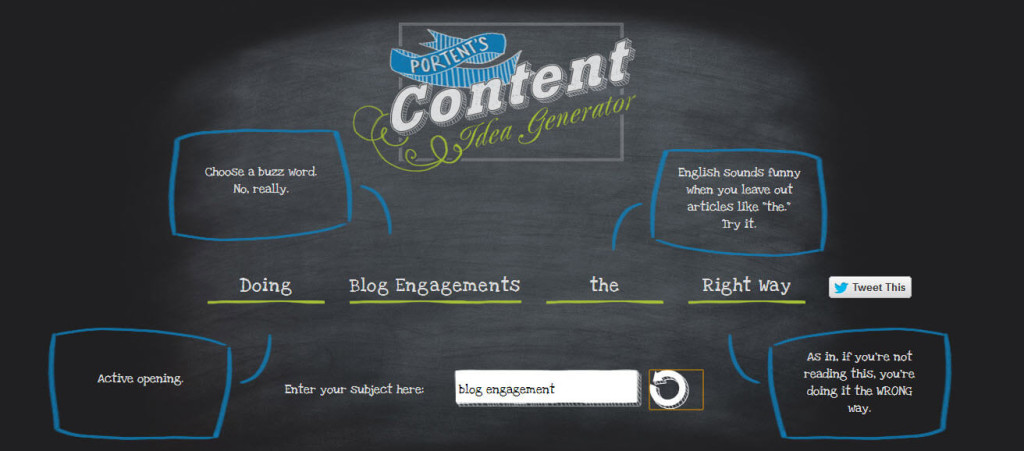Anyone can write a blog. Just put one word in front of another until you reach the 500 mark. Sprinkle in a few keywords, buy a stock shot and you’re all done. Right?
WRONG!
Creating a piece of blog content that’s engaging, relevant and interesting to your audience takes careful consideration. For bloggers old and new writing a post that generates an avalanche of likes, tweets, Google Pluses and genuine comments can be a real struggle.
That’s why the team at Louder.Online have created this easy checklist to help you create super engaging blog content, first time and every time!
Step 1: Do your research
Before you start your blog post it’s important to do a little research, consider:
- Checking out what your competitors are writing about.
- Googling possible post titles and read what you find.
- Playing around in Google Adwords to see if there’s a new way to approach a well-trodden topic.
Think about creating a file on your desktop where you save your favourite posts for later inspiration. Or set up a spreadsheet to store links, research and title ideas.
Step 2: Consider your objective
We often hear about people writing blogs simply to please Google and improve their ranking. If that’s your objective, stop right now. Your aim should always be to inform, engage and entertain your readers. Put humans first and Google bots second and you’re onto a winner.
Step 3: Choose a subject you’re passionate about
Obviously it makes sense to write about a subject matter you know well but possibly more important is to write with true passion. Enthusiasm often speaks louder than facts and figures. By choosing to write about a topic you really love, you’ll find the words flow easily and you never experience the dreaded writer’s block.
Often a way to inject passion is to make the post personal. No you don’t have to spill your guts about a traumatic childhood incident, but you can give your opinion and perspective.
Readers respond to real posts that are written from the heart. Tweet This
Step 4: Create a blogging template
Few or us are so lucky we can just sit down and ‘let the magic happen’. So it’s a good idea to create your own blogging template or structure that includes:
– Title: Create a short and snappy title with the most important words at the start. Use this fun title generating tool to help you get some ideas.
– Snippet: Write a short 50-word intro that can be used as your excerpt.
– Pull quote: Try to write and pull a special quote from the article that sums everything up nicely.
– Intro or teaser: Outline what you want to discuss in 50 words or fewer.
– The middle bit: Consider starting the core of your blog with a personal or true story. If you’re writing about how to deal with difficult clients, share your story of a dreadful client you once worked with. Not only does this give the blog some context, it draws readers in.
– The bigger picture: Once you’ve told your personal story, ease into the bigger picture and discuss things in more general terms all your readers can relate to.
– Further reading: You can either save further reading for the end of your article, or add it throughout. Make your argument or discuss your issues, then offer the reader opportunities to read more.
– Conclusion: Sum up your article and answer any questions you raised in the intro.
– Questions: Pose a question to your reader. What was their experience of the issue? How do they feel about your suggestions? What would they do differently?
When you work with a set blog structure, it’s easy to manage even the most difficult subjects.
Step 5: Choose an awesome image
Along with your blog title the image is the most powerful way to encourage users to click on your blog and read. So it’s vital to choose an impactful (good word creation here right?) image. There are several ways to find great images for your blog:
– Sign up to some free image stock suppliers or invest a small budget in more high quality paid image sites like istock.
– Look for images with no copyright restrictions or a Creative Commons license on Flickr
– Create your own images and illustrations
– Use a great free photo editing tool like PicMonkey to give your pictures a unique style.
Step 6: Mix it up a little
A really great blog has a mix of content lengths and types. So if you’re always posting 2000 word how to style articles then consider a shorter post that gives your personal opinion on a contemporary issues. Other idea for mixing it up include:
– Interviews with relevant personalities in your industry
– Question and answer type posts
– Reviews of products or services
– Photo blogs with minimal writing
– Controversial posts that attack an established view point
By shaking up the format every once in a while you’ll attract new readers and encourage more sharing and caring.
Step 7: Make a video
Video blogs are a great way to increase engagement and time on site (both things that Google loves). It may be too daunting to consider a talking head style videos but don’t worry there are other options. How about using a screen capture tools to create a simple how to video? We like to use Screenflow, here’s a great little video on how to use it.
Step 8: Learn to link
You might think including links to other sites is a bad thing, but it’s not. Including links to further reading shows you’re genuinely trying to you’re your readers useful content instead of just keeping them trapped on your site. Just be sure to:
– Launch links to external sites in a new window.
– Underline words so your readers know where to click.
Another great idea is to create internal links from one blog post to another. Check your Google Analytics to see which of your blog posts are achieving high traffic and then link the to new post where relevant. Not only with the SEO juice will flow through but your readers will enjoy an easy journey through your site.
Step 9: Ask for feedback
Make sure you ask for feedback at the end of your blog post. You can do this by raising a question or starting a debate. But have realistic expectations: the rule of thumb is that for every 100 readers, only 1 or 2 will actually take the time to comment.
Make sure you the question you ask is easy to answer questions like ‘what drives you crazy about xxx’ or ‘what’s your favourite way to use xxx’ require almost no thought to answer and so they get heaps of comments.
When people do comment, it’s important to deal with their comments in a professional and considered way. Here are some recommendations:
– Respond: Answer each comment quickly and politely. Address their points and, if possible, encourage them to comment again.
– Be humble: No matter how much you know about your subject matter, the likelihood is that, collectively, your readers know more. If a commenter challenges your thinking, don’t take it personally. Instead, be thankful rejoice in the fact that they’ve taken the time to share their thoughts with you and thank them.
– Handle trolls with care: If you receive a rude or aggressive comment, don’t rush to press the ‘delete’ button. Instead thank them for their contribution and respect their opinion. Don’t add fuel to the fire by challenging them (unless you have some time on your hands).
Step 10: Share everywhere!
Once you’ve written your blog, you’ll obviously share it across your social networks. But look for opportunities to share it elsewhere. If you’re a member of a group, community or forum, why not share your blog post as part of a relevant discussion? Just remember to respect the forum rules, and never spam people.
Also be sure to make it easy for your readers to share your content:
– If you’re using WordPress there are a stack of sharing plugins, one of our favourites is Shareaholics Sexy bookmarks or Digg Digg.
– There are heaps of other free sharing tools such as Addthis and
Why go to all the trouble?
By following these ten simple rules every time you create a blog post, we believe you’ll be well on the way to creating great blog content.
But it seems like a lot of effort, right?
Believe us, it will be worth it.
Getting comments and share isn’t just about improving your sites position in the ranking. It’s good for your own motivation. Often writing a blog can feel like shouting into the wilderness: “Is anybody out there?”
By generating more likes and comments and this will boost your blogging confidence. You’ll know people are reading and enjoying your posts and that what you’re writing is touching people.
We all need a little pat on the bag now and again right? That’s what engagement is. It’s digital affirmation that we’re doing things right.
But here’s one more thing to think about.
When you finish writing your blog post, sit down and read it out loud.
Then ask yourself, “Would I share this blog with my friends if SEO wasn’t an issue?”
If the answer is yes, then you’ve done your job. Well done.
If the answer is no the, sorry, but it might be time for a rewrite.
Over to you
Do you follow these steps when writing your blogs posts? Are there any steps we’ve missed you think are essential?





